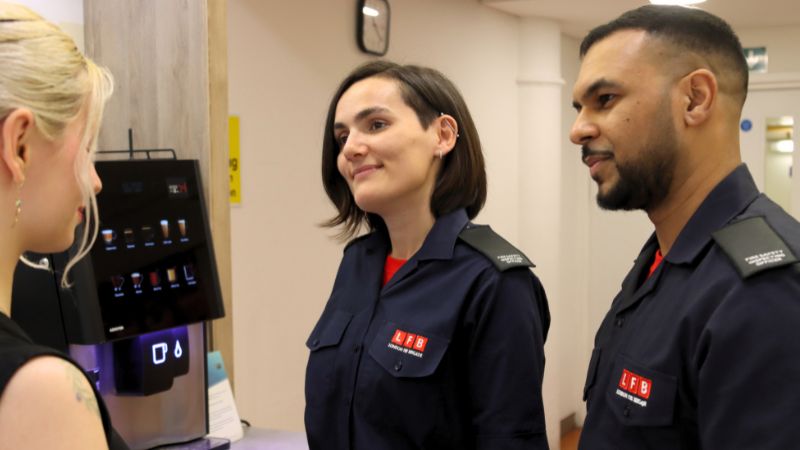How we can help
If you're responsible for any commercial or industrial building in London, or any residential building with two or more separate homes in it, we can offer advice or guidance on various fire safety issues, including:
- Alarms
- Emergency evacuation plans
- Emergency lighting
- External wall systems (for example cladding and living/green walls)
- Fire doors
- Fire engine access and water supply
- Fire engineering
- Firefighting equipment
- Fire safety staff training
- Historic buildings
- Hospitals
- Means of escape
Contact us:
- Call us on 020 8555 1200 ext 89170 during office hours (Monday - Friday, 9am – 5pm)
- Or via our contact us form
Fire Risk Assessments
We're often asked to help people carry out a Fire Risk Assessment, but our role as the enforcing authority would make that a conflict of interest. However we do offer some advice on our Fire Risk Assessments page, including a list of competent assessors.
Building inspections
We inspect buildings to ensure they're safe from fire and comply with legislation.
Why we carry out inspections
Our team of Fire Safety Inspecting Officers and Fire Safety Advisors will carry out inspections in the following situations:
A serious fire risk has been reported
When we receive reports of fire risks from members of the public we'll visit the building concerned within three hours. Find out more about how these reports are made and dealt with on our serious fire risks page.
A fire has occurred in a building
When there's a fire in a building covered by the Regulatory Reform (Fire Safety) Order 2006, as amended by the Fire Safety Act 2021, an inspecting officer or fire safety advisor will carry out an inspection if certain criteria are met - for example if someone was injured or died.
We carry out these inspections:
- To see if the building was compliant with fire safety legislation
- To find out whether the fire was preventable
- To make sure the building is still safe
- To prevent similar incidents occurring in the future
As part of a regular programme of inspections
Buildings in London are given a risk score. This is based on the type of building and the type of risks the people who live or work there may experience. For example, care homes would usually receive a higher risk score.
Buildings with a high enough risk score will be part of our regular programme of inspections, and the higher the score, the more frequently we'll inspect it.
How to tell if the person visiting is a genuine inspecting officer or adviser
Usually we'll get in touch before an inspection to arrange a time to visit, but that's not always possible, so if you're not sure if the person at your door is a genuine Fire Safety Inspecting Officer or Fire Safety Advisor ask to see their warrant card. On the warrant card there is a number - 020 8555 1200 - you can call to confirm.
Here's an example of a genuine warrant card:

Inspecting Officers in a cafe
How long an inspection takes
How long an inspection will take depends on the size of the building and what exactly is being inspected. For most properties it will take between 30 minutes to one hour.
Some large and complicated premises, such as hospitals or historic buildings, could take up to three hours.
How to prepare for an inspection
We don't want to disrupt your premises for longer than necessary, so here are a few things you can arrange in advance that will speed things up:
- Make someone available to show us around the building, ideally someone with some responsibility for fire safety
- Have your fire safety records to hand
- We may like to talk to some staff working in the building, so if you could make them available, that will help
What happens after an inspection
Where possible we'll talk to you informally during the visit about any changes you need to make, and offer any advice we think is needed.
Once the inspection is complete the local Fire Safety Inspecting Officer or Fire Safety Advisor will give it one of the following classifications depending on the level of risk:
- Broadly complaint - this means we'll give the person responsible for the building advice, verbally, on what they need to do, if anything
- Notification of fire deficiencies - (also called a NOD) we'll give the responsible person a written document outlining actions they need to take and a deadline for those actions. We may return to check.
- Enforcement notice - we'll give the responsible person a written document outlining actions they need to take and a deadline for those actions. We may return to check. It also goes onto a public register.
- Enforcement notice - consider prosecution - this is the same as the enforcement notice above, but we also consider whether we want to prosecute.
- Article 31 (a restriction/prohibition notice) - this is where we restrict the use of a building (for example by specifying that people can't sleep there) or block the use of a whole building, or section of building. It's a written document, legally binding, supplied to the responsible person, and displayed on the premises. We'll carry out spot checks to make sure the restriction or prohibition is being followed.
If the outcome is anything other than 'Broadly compliant' you'll receive a written document in the following weeks - the Inspecting Officer or Advisor will let you know when you're likely to receive it.
If you're concerned about an inspection please remember that taking enforcement action is a last resort, and we will try to work with you to resolve risks as quickly as possible before it reaches that stage.

